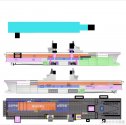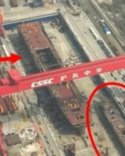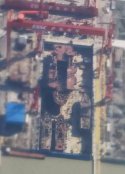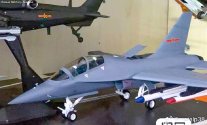Actually, the overhangs admid ship and the removal of the large rear elevator (present in the 075) actually do give at least the possibility of an angled deck. Without those no one would even suggest it.
March:
View attachment 128642
April:
View attachment 128643
The overhangs are different from every other LHD/LHA including the fighter capable
America class. The flight deck is not installed yet. But it will be wider than the width of the hull. This is something that is more in common with the construction of full fledged carriers.
The collection of academic papers on the LHD so far seem to suggest otherwise, but we shall wait and see.

The JL-10J will reduce the wear and tear on frontline aircraft as the carrier program matures.
Over time, the syllabus would change from J-15 at every stage from land to sea to JL-10J on beginners courses on land to the initial stages on STOBAR and CATOBAR. Only by final certification do we fly J-15s and J-35s (along with KJ-600s and the inevitable CODs which will need a turboprop trainer.)
If China is building its own alligator carrier force based on an EM catapult and smaller 076 hulls then the syllabus for those being trained here will include courses for the JL-10J on the 076.
All conjecture of course. These are exciting times!
Honestly, what's with the obsession of trying to make the JL-10J into carrier-based frontline fighters anyway - Or more specifically, trying to lob them onto the flight decks of the 076 LHDs anyway?
Look, I'm not against the JL-10 having a carrier-based variant, which can be used for training of naval aviators onboard CVs. But CVs and LHDs, by nature, have fundamentally different roles to one another, such that trying to impose one key functionalities to the other incurs significant downsides, which would make having such move being not worth it.
Unless the opposing force is some fourth-rate air force with only a handful or two of light-weight fighters, and with little to no SAM systems to speak of - Trying to send a handful of light-weight fighters (of which the JL-10 is in the category) against opponents that even have a somewhat respectable prowess to speak of (let alone those more powerful ones) will only result in a major waste of precious lives and equipment, and with negligible gain to speak of.
China isn't exactly as lacking in the fighter department as their neighbors to the south and southwest, such that they would have to fall back to light-weight fighters to conduct their frontline duties. That's why the PLAAF operates zero JF-17s, but hundreds of J-10s (which is a medium-weight fighter BTW) as their lightest modern fighter model in the entire fleet.
Besides, just as mentioned above - Unless things go catastrophically south for the PLA during wartime (of which the situations that enable such operations would no longer exist), any amphibious assault operations within the 1IC (bar the southern edges of the SCS) will not suffer from the lack of aerial support and cover by the PLAAF and PLANAF launched from bases on the mainland to such a degree that an organic fighter airwing is required for each of the PLAN LHDs. There's also the PLAN with their 2 (soon to be 3) CVs, which too can provide aerial support and cover for the LHDs and their amphibious task forces with carrier-based fighter airwings.




